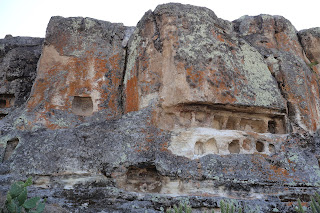Ventanillas de Otuzco are a Peruvian archaeological site located in the
district of Baños del Inca, 8 km northwest of the city of Cajamarca.
The site is located on volcanic rock, covering an area of about 1,700 square
metres (18,000 sq ft).
It has an antiquity of 300 BCE - 200 CE of the Early Intermediate period.
|
Going up to the funeral complex
|
|
Ventanillas de Otuzco funeral complex
The word Otuzco or “Otushco” comes from “Oto” meaning “moth-eaten”,
which refers to the holes that characterize the windows.
-
The archaeological site is located at 2,850 meters (9,350 ft) above
sea level, has an elongated shape and an area of approximately 1,600
square meters (17,222 square feet).
-
It was built on the Llanguil hill, cutting the surface of trachyte
rock (volcanic igneous rock) through small holes in the shape of
windows or niches.
-
Most of the windows have unfortunately been looted by means of
"huaqueos" (looting), however the characteristics of their structure
and the few cultural elements found in them allow us to determine a
funerary function, as a cemetery or necropolis.
-
From Llanguil Hill you can see the landscape in a panoramic way,
strategically dominating the entire environment.
-
This characteristic was very important for the construction of
cemeteries in pre-Hispanic times, because it was believed that
deceased people became protective ancestors.
-
The small windows as a funerary pattern are very characteristic of the
Cajamarca culture, spread throughout the basin of the Chonta and
Llaucán rivers.
-
We can find many more Ventanillas in several Cajamarca provinces:
- Bellavista and Corisorgona, in Bambamarca.
- Combayo and Cerro Consejo, in Cajamarca.
- Catán and Tolón, in Contumazá.
- Chacapampa, in San Pablo.
- Jangalá, in San Miguel.
- San Marcos, in San Marcos.
|
|
Ventanillas de Otuzco investigations
The Ventanillas de Otuzco archaeological site was used as a cemetery for
a long period of time, approximately 2,000 years.
-
During the excavations a great variety of ceramic vessels were found:
-
Pots and bowls from the Late Huacaloma Phase (1,000 - 550 BCE)
-
Bottles, plates and bowls from the Early Cajamarca Phase (200 - 450
CE)
-
Plates, spoons and bowls from the Middle Cajamarca Phase (450 -900
CE)
- Plates from the Late Cajamarca Phase (900 - 1,200 CE)
-
The tools were made from pebbles (rounded stones) using the percussion
technique (striking two stones together).
-
Most of the stone artifacts had an agricultural function, such as axes
and hoes (pickaxes).
Discovery of a human burial
-
A complete human burial was found during excavations inside one of the
niches.
-
It corresponds to a child, of undetermined sex and approximately 9 to
12 years old.
-
It was placed in a fetal position, with the legs bent to the left
side, the arms also bent over the chest and the hands possibly
covering part of the face.
-
The state of preservation of the bones was very delicate, having to be
carefully cleaned and consolidated.
-
The rest of the bone material recovered from the windows corresponds
to people between approximately 10, 18 and 25 years old.
|
|
The last home of the Cajamarca
The Windows:
-
A total of 337 carved niches have been recorded. They are rectangular
or quadrangular in shape and are arranged in superimposed rows.
-
The dimensions of the windows vary between 22 cm (8.6 in) and 60 cm
(23.6 in) wide and 30 cm (11.8 in) and 75 cm (29.5 in) high.
-
The niches have smooth, flat sides, while the base is concave. We can
observe two types: simple and multiple.
-
In the upper part of the monument, niches have been recorded that are
made flush with the floor, in the form of a cross and in the form of
an E.
-
The Ventanillas de Otuzco Archaeological Zone was declared Cultural
Heritage of the Nation on February 19, 2003, through National
Directorial Resolution No. 75 / INC.
The Simple Windows:
- They form the majority of the niches recorded.
- They have direct access and were designed as uniform rows.
-
Each of them has an “internal flange” carved in stone 3 cm (1.1 in)
high, which serves to adapt a flat stone as a cover for the niche.
The Multiple Windows:
- There are only three of the niches recorded.
-
Inside each one there are up to thirteen cavities distributed on both
sides of a central corridor.
The Cornices:
-
They are strips or overhangs carved into natural rock, which protrude
from the external walls of the niches.
-
They serve an important function, protecting the niches from rain and
runoff, preventing water from entering each window.
-
Some windows have gabled cornices imitating the traditional roofing
style of mountain houses.
The Isolated Windows:
-
They are located in the southern part of the site, and were made in a
scattered manner taking advantage of the longest parts of the natural
rock.
|
|
Southern panorama of Ventanillas de Otuzco (left)
|
|
Central panorama of Ventanillas de Otuzco (center)
|
|
Northern panorama of Ventanillas de Otuzco (right)
|
See also
Source
Location



























